
Lazurite, old name Azure spar is a tectosilicate mineral with sulfate, sulfur and chloride with formula (Na,Ca)8[(S,Cl,SO4,OH)2|(Al6Si6O24)]. It is a feldspathoid and a member of the sodalite group. Lazurite crystallizes in the isometric system although well‐formed crystals are rare. It is usually massive and forms the bulk of the gemstone lapis lazuli.

Petalite, also known as castorite, is a lithium aluminum tektosilicate mineral LiAlSi4O10, crystallizing in the monoclinic system. Petalite occurs as colorless, pink, grey, yellow, yellow grey, to white tabular crystals and columnar masses. It occurs in lithium-bearing pegmatites with spodumene, lepidolite, and tourmaline. Petalite is an important ore of lithium, and is converted to spodumene and quartz by heating to ~500 °C and under 3 kbar of pressure in the presence of a dense hydrous alkali borosilicate fluid with a minor carbonate component. Petalite (and secondary spodumene formed from it) is lower in iron than primary spodumene, making it a more useful source of lithium in, e.g., the production of glass. The colorless varieties are often used as gemstones.

Zoisite, first known as saualpite, after its type locality, is a calcium aluminum hydroxy sorosilicate belonging to the epidote group of minerals. Its chemical formula is Ca2Al3(SiO4)(Si2O7)O(OH).

Vivianite (Fe(II)
3(PO
4)
2·8H
2O) is a hydrated iron(II) phosphate mineral found in a number of geological environments. Small amounts of manganese Mn2+, magnesium Mg2+, and calcium Ca2+ may substitute for iron Fe2+ in its structure. Pure vivianite is colorless, but the mineral oxidizes very easily, changing the color, and it is usually found as deep blue to deep bluish green prismatic to flattened crystals. Vivianite crystals are often found inside fossil shells, such as those of bivalves and gastropods, or attached to fossil bone. Vivianite can also appear on the iron coffins or on the corpses of humans as a result of a chemical reaction of the decomposing body with the iron enclosure.

Adamite is a zinc arsenate hydroxide mineral, Zn2AsO4OH. It is a mineral that typically occurs in the oxidized or weathered zone above zinc ore occurrences. Pure adamite is colorless, but usually it possess yellow color due to Fe compounds admixture. Tints of green also occur and are connected with copper substitutions in the mineral structure. Olivenite is a copper arsenate that is isostructural with adamite and there is considerable substitution between zinc and copper resulting in an intermediate called cuproadamite. Zincolivenite is a recently discovered mineral being an intermediate mineral with formula CuZn(AsO4)(OH). Manganese, cobalt, and nickel also substitute in the structure. An analogous zinc phosphate, tarbuttite, is known.
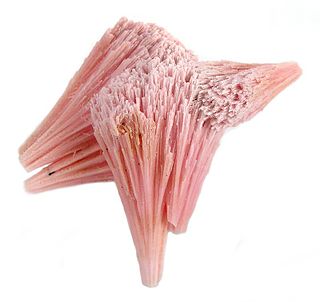
Kutnohorite is a rare calcium manganese carbonate mineral with magnesium and iron that is a member of the dolomite group. It forms a series with dolomite, and with ankerite. The end member formula is CaMn2+(CO3)2, but Mg2+ and Fe2+ commonly substitute for Mn2+, with the manganese content varying from 38% to 84%, so the formula Ca(Mn2+,Mg,Fe2+)(CO3)2 better represents the species. It was named by Professor Bukowsky in 1901 after the type locality of Kutná Hora, Bohemia, in the Czech Republic. It was originally spelt "kutnahorite" but "kutnohorite" is the current IMA-approved spelling.
Rhomboclase is an acidic iron sulfate mineral with a formula reported as H5Fe3+O2(SO4)2·2(H2O) or HFe(SO4)2·4(H2O). It crystallizes in the orthorhombic system and typically occurs as tabular crystals with a rhombic outline. It occurs as transparent colorless, blue, green, yellow or grey crystals with a vitreous to pearly luster.
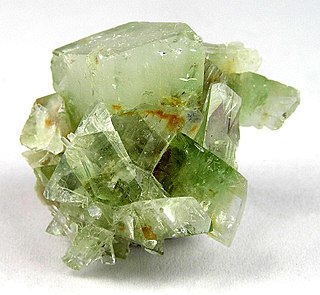
Augelite is an aluminium phosphate mineral with formula: Al2(PO4)(OH)3. The shade varies from colorless to white, yellow or rose. Its crystal system is monoclinic.

Berlinite (aluminium phosphate, chemical formula AlPO4 or Al(PO4)) is a rare high-temperature hydrothermal or metasomatic phosphate mineral. It has the same crystal structure as quartz with a low temperature polytype isostructural with α–quartz and a high temperature polytype isostructural with β–quartz. Berlinite can vary from colorless to greyish or pale pink and has translucent crystals.
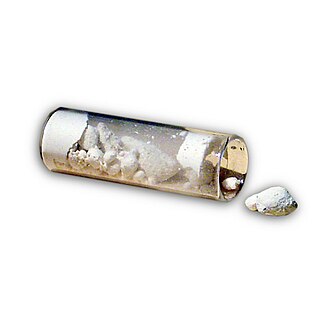
Taranakite is a hydrated alkali iron-aluminium phosphate mineral with chemical formula (K,Na)3(Al,Fe3+)5(PO4)2(HPO4)6·18 H2O. It forms from the reaction of clay minerals or aluminous rocks with solutions enriched in phosphate derived from bat or bird guano or, less commonly, from bones or other organic matter. Taranakite is most commonly found in humid, bat inhabited caves near the boundary of guano layers with the cave surface. It is also found in perennially wet coastal locations that have been occupied by bird colonies. The type location, and its namesake, the Sugar Loaf Islands off Taranaki, New Zealand, is an example of a coastal occurrence.

Cyrilovite (NaFe33+(PO4)2(OH)4·2(H2O)) is a hydrous sodium iron phosphate mineral. It is isomorphous and isostructural with wardite, the sodium aluminium counterpart.

Hureaulite is a manganese phosphate with the formula Mn2+5(PO3OH)2(PO4)2·4H2O. It was discovered in 1825 and named in 1826 for the type locality, Les Hureaux, Saint-Sylvestre, Haute-Vienne, Limousin, France. It is sometimes written as huréaulite, but the IMA does not recommend this for English language text.

Tsumebite is a rare phosphate mineral named in 1912 after the locality where it was first found, the Tsumeb mine in Namibia, well known to mineral collectors for the wide range of minerals found there. Tsumebite is a compound phosphate and sulfate of lead and copper, with hydroxyl, formula Pb2Cu(PO4)(SO4)(OH). There is a similar mineral called arsentsumebite, where the phosphate group PO4 is replaced by the arsenate group AsO4, giving the formula Pb2Cu(AsO4)(SO4)(OH). Both minerals are members of the brackebuschite group.
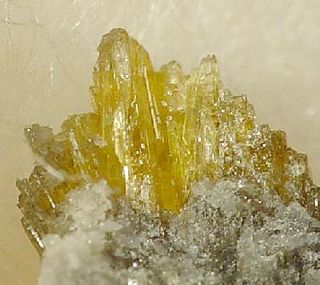
Warikahnite is a rare zinc arsenate mineral of the triclinic crystal system with Hermann-Mauguin notation 1, belonging to the space group P1. It occurs in the Tsumeb mine in Namibia on corroded tennantite in the second oxidation zone under hydrothermal conditions in a dolomite-hosted polymetallic ore deposit. It is associated with adamite, stranskiite, koritnigite, claudetite, tsumcorite, and ludlockite. The origin of discovery was in a dolomite ore formation within an oxidized hydrothermal zone, in the E9 pillar, 31st level of the Tsumeb Mine in Namibia, Southwest Africa. It has also been found at Lavrion, Greece and Plaka, Greece as microscopic white needles.
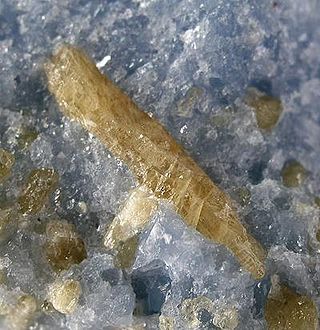
Fluorellestadite is a rare nesosilicate of calcium, with sulfate and fluorine, with the chemical formula Ca10(SiO4)3(SO4)3F2. It is a member of the apatite group, and forms a series with hydroxylellestadite.
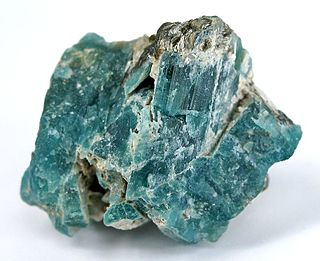
Grandidierite is a rare mineral that was first discovered in 1902 in southern Madagascar. The mineral was named in honor of French explorer Alfred Grandidier (1836–1912) who studied the natural history of Madagascar.
Xitieshanite is a hydrous iron sulfate–chloride mineral with chemical formula: Fe3+(SO4)Cl·6(H2O).
Cattiite is a phosphate mineral. The mineral was first found in a veins of dolomite carbonatites veins at the bottom of the Zhelezny (Iron) Mine in the Kovdor massif, Kola Peninsula, Russia. Cattiite was tentatively identified as Mg3(PO4)2·22H2O, which as a high hydrate magnesium orthophosphate. Later structural studies, revealed the existence of two polytypes named Mg3(PO4)2·22H2O-1A1 and Mg3(PO4)2·22H2O-1A2.

Paravauxite is a rare phosphate mineral that was named in 1922. Its name is a portmanteau word made by blending the Greek word for near and vauxite due to the chemical relationship to vauxite. It was approved by the IMA, and was first described in 1959. It is now grandfathered, meaning it is probably to remain a species.

Kidwellite in an uncommon mineral that was discovered in Arkansas in the United States. It was approved by the IMA in 1974, but it was only named in 1978 by Moore and Ito after Albert Lewis (Laws) Kidwell.

















